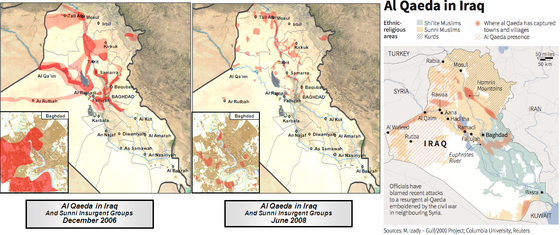Over the past several days, the Islamic State of Iraq and the Sham, al Qaeda's affiliate in Iraq, has taken control of large sections of two western Iraqi cities that were once bastions for the terror group.
ISIS fighters entered the cities of Fallujah and Ramadi, the provincial capital of Anbar, after the Iraqi military withdrew from them following clashes with tribes over a political standoff that resulted in the arrest of a Sunni member of parliament.
The ISIS has posted videos of its fighters entering the cities in force after clashing with Iraqi police and overrunning several checkpoints. In the videos, a large convoy of ISIS fighters driving technicals, or pickup trucks with heavy machine guns mounted on the back, is seen moving through Ramadi. The fighters are flying al Qaeda's black banner while singing praises to al Qaeda and its "Islamic state." [See more videos here.]
Officials from the Iraqi Interior Ministry acknowledged that parts of Fallujah and Ramadi are under al Qaeda control.
"Half of Fallujah is in the hands of ISIS (the Qaeda-linked Islamic State of Iraq and the Sham) group," an anonymous interior ministry official told AFP.
"In Ramadi, it is similar - some areas are controlled by ISIS," the official continued. The other parts of the city are controlled by "tribesmen," likely a reference to the Sahwa ("the Awakening"), the tribal militia that with US backing ejected al Qaeda from control of large areas of Anbar between 2006 and 2009.
In Fallujah, ISIS fighters stormed the main police headquarters, freed more than 100 prisoners, and seized weapons and ammunition. "Other police stations in the city were torched by fighters as most police abandoned their posts," Al Jazeera reported.
Iraqi special forces are said to be battling ISIS fighters in Fallujah and Ramadi. The status of nearby cities and towns is not known, but the ISIS has been active in cities such as Haditha, where in March 2012 a large force attacked police stations and executed policemen and their commanders. The ISIS has also staged raids in other cities such as Hit and Rawa.
Ramadi and Fallujah, sizeable cities with populations of several hundred thousand each, once served as the hubs for al Qaeda in Iraq, the predecessor of the ISIS. From 2004 to early 2007, large areas of the two cities were either controlled by al Qaeda or were contested. The Awakening and US and Iraqi forces waged a protracted counterinsurgency to clear al Qaeda from the two cities as well as from surrounding cities and towns along the Euphrates River Valley.
The ISIS has been targeting Iraqi security forces as well as the Awakening in a series of high-profile suicide assaults and bombings in Anbar. Just two weeks ago, the ISIS killed the commanding general of the 7th Division, one of the division's brigade commanders, and 16 staff officers and soldiers in a suicide attack in Rutbah. The ISIS set a trap for the division commander as he toured an area thought to have been cleared of the terror group. The 7th Division is made up primarily of soldiers and officers from Anbar province.
Al Qaeda regaining control of areas in Iraq it lost during the surge
The ISIS has had success in regaining control of areas of Iraq that it lost during combined US and Iraqi counterinsurgency operations from 2007 to 2009. A map recently produced by Reuters shows that the ISIS controls villages and towns along the Euphrates River and the border with Syria as well as in the desert in Anbar, in areas south of Baghdad, in the Hamrin Mountains in Diyala and Salahaddin, and in numerous areas in Ninewa [map is below].
When the Reuters map is compared with maps produced in 2008 by Multinational Forces - Iraq that show al Qaeda control in Iraq in 2006 [leftmost map] at the height of the organization's strength in the country, and 2008 [center map] after the group was driven from many of its sanctuaries, al Qaeda's resurgence becomes clear.
The ISIS began retaking control of areas in Iraq after the US withdrew military, intelligence, and logistical support from the Iraqi military and intelligence services and abandoned its support of the Awakening in December 2011. The Syrian civil war and a political standoff between Prime Minister Maliki and Sunnis in Anbar have also fueled the resurgence of al Qaeda in Iraq.
In Syria, the ISIS and the Al Nusrah Front for the People of the Levant, al Qaeda's other branch in Syria, and allied Islamist groups from the Islamic Front control large areas in the northern and eastern portions of the country.
| Image may be NSFW. Clik here to view.  |
| For a larger image, click the map. Left and center maps: these two maps were produced by MNF-I in 2008 to show how al Qaeda was driven from its sanctuaries during the surge. Dark red indicates control; light red indicates presence. Right map: this map was produced by Reuters in December 2013. |